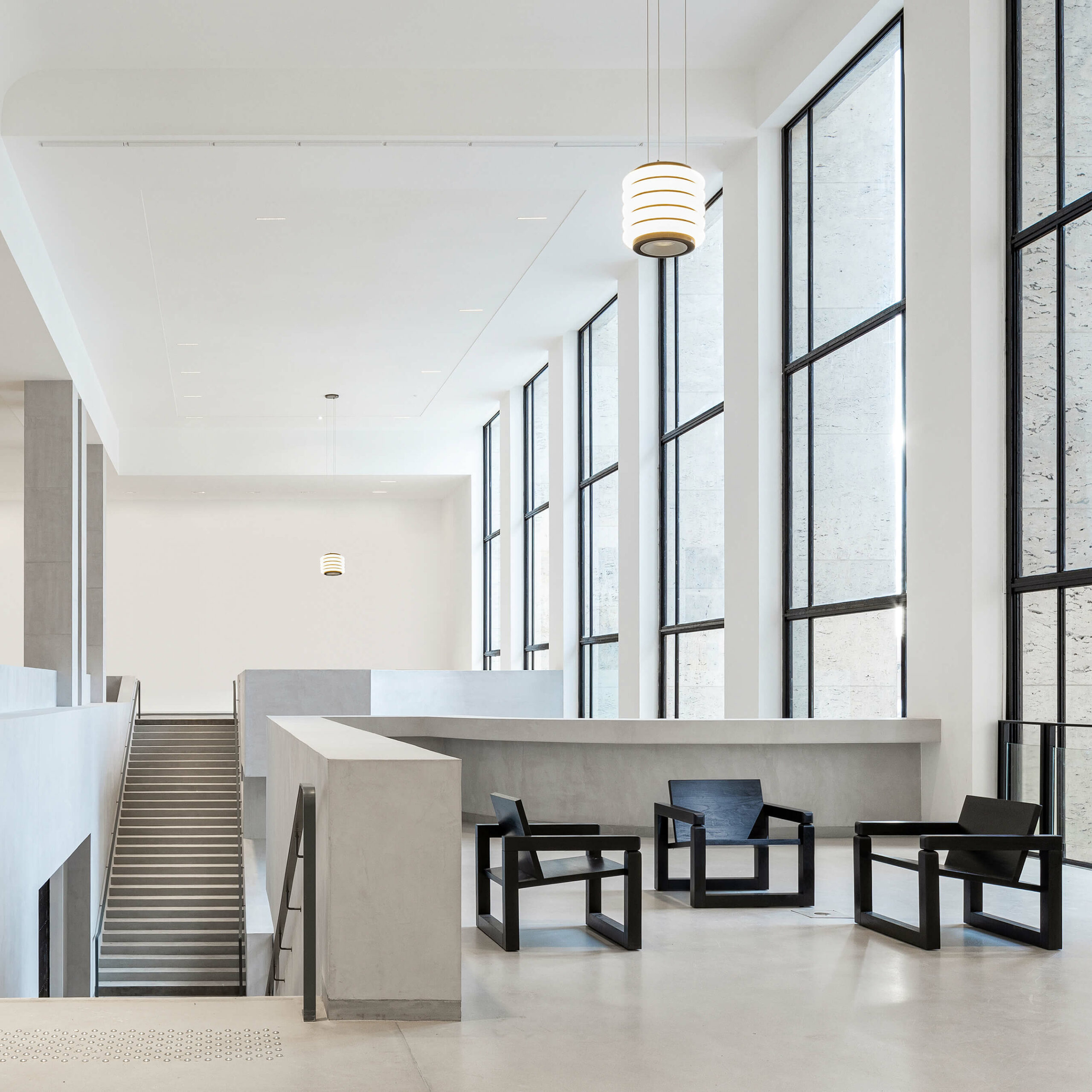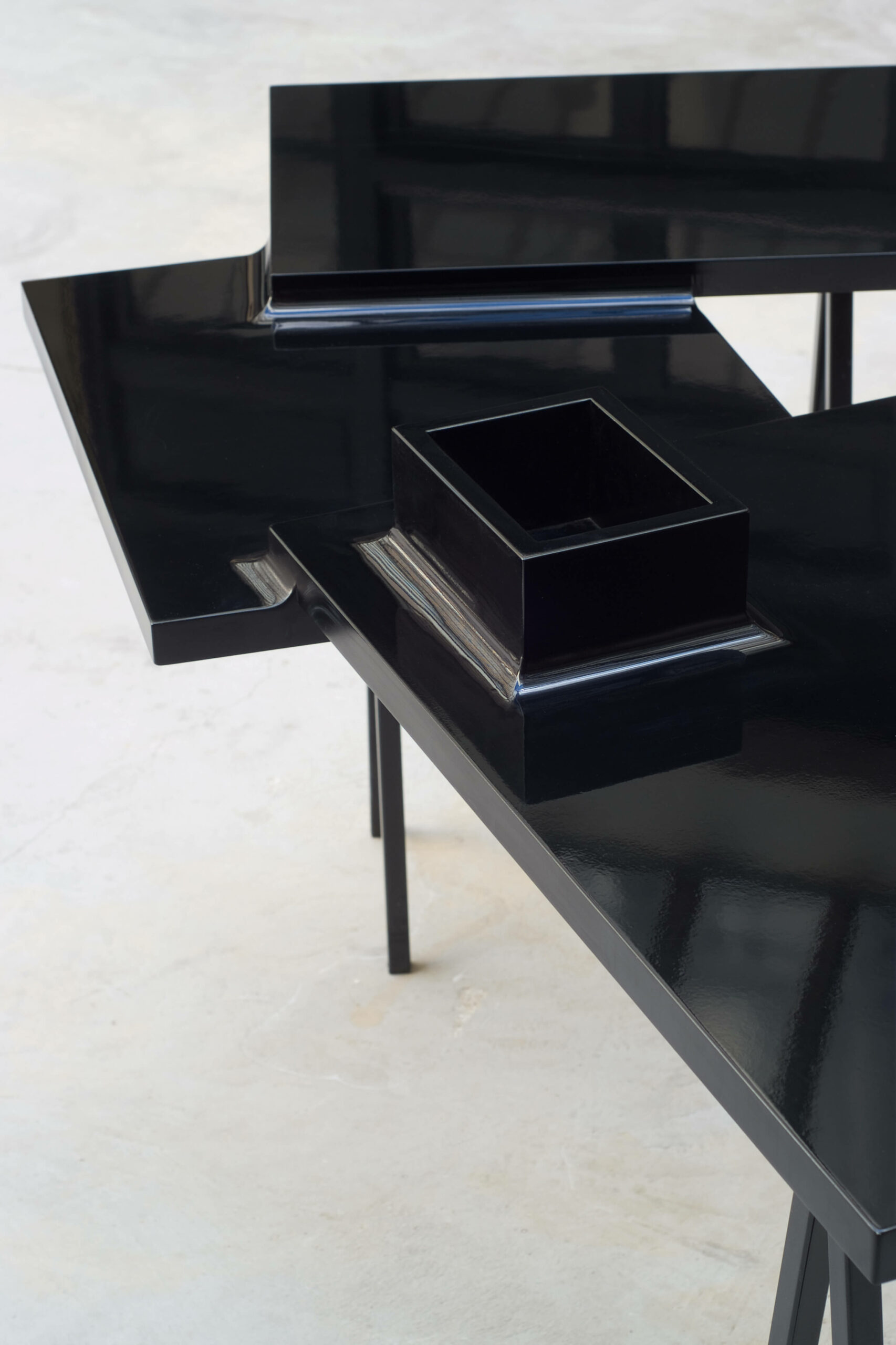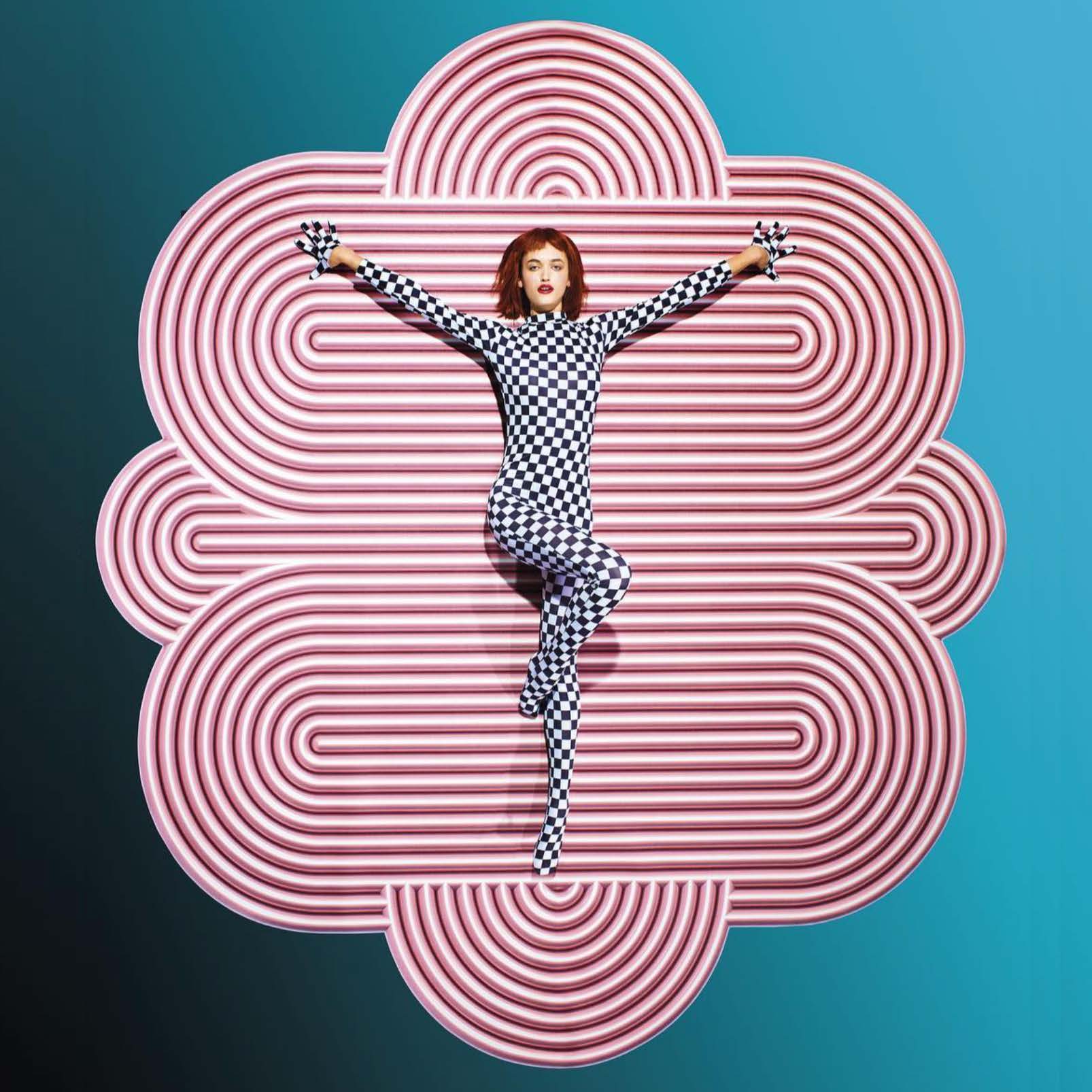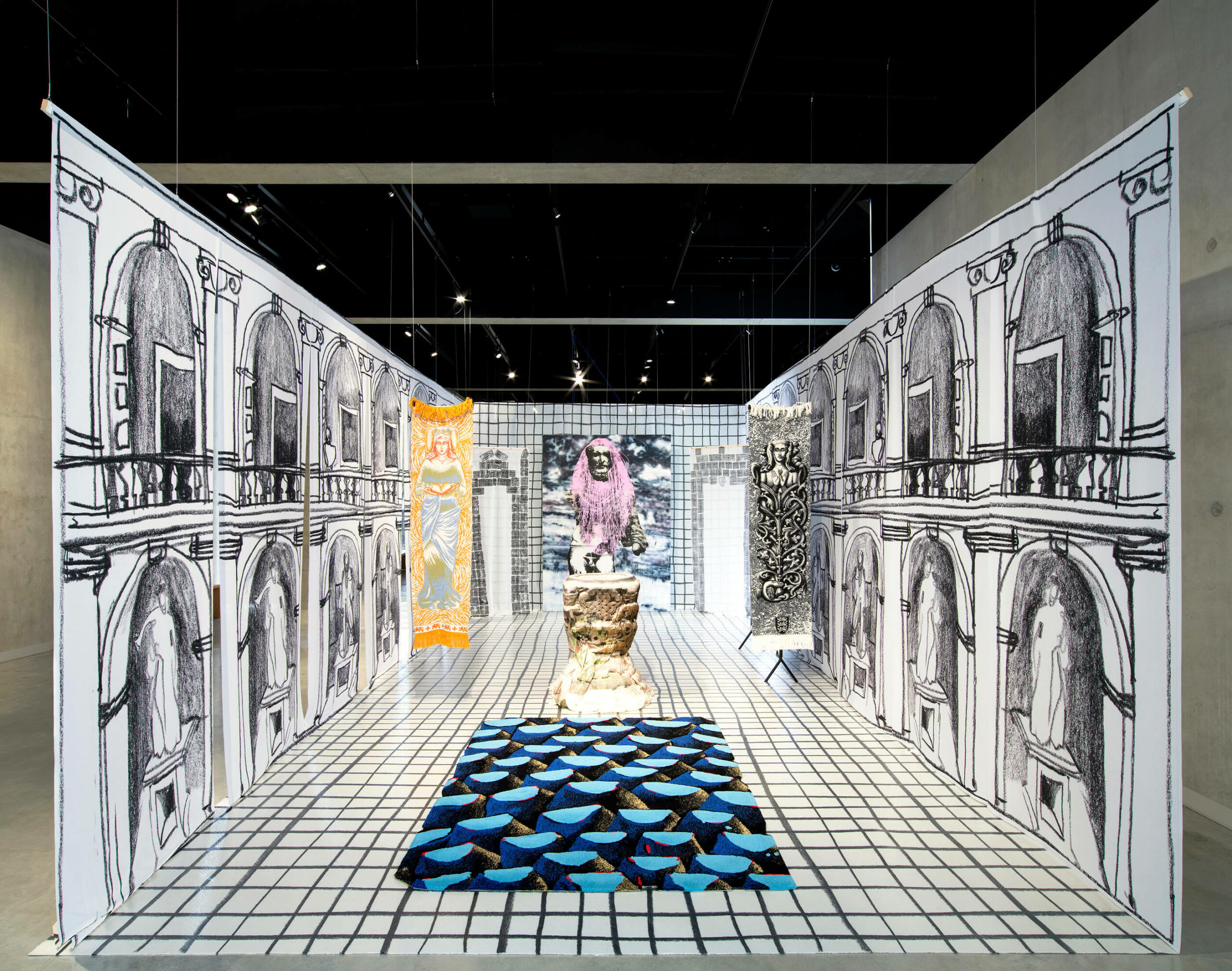
Painter in letter: Bonnefrite
Studio GGSV design team: Lucie Labadie, Delphine Mériaux, Audrey Bigot, Théophile Blandet
Location: Cité du design – Manufacture site
production: City of Design
manufacturing: Workshop of the City of Saint-Etienne
Year: 2015
Area: 450 m2
Photos : Johan Meallier
The factory space is transformed into a makeshift cathedral. Six thematic altars stand and question hypothetical cults devoted to data, science and the environment on the one hand, to perception, illusion and beliefs on the other.
This exhibition aims to articulate composite reflections and does not claim to make any inventory. It offers a story created from scratch.
Data / Data
Ten years ago, during the Biennale Internationale Design Saint-Étienne, we discovered strange white cylinders. Their authors, Drew Allan and Andy Huntington transformed a sound sequence into a sculpture, a piece of data into an object. Form follows here, no longer function, but information.
These pieces then inaugurated a new genre of expression for design: the representation of data. Information becomes the engine that generates forms, something philosophers have known since they spoke Greek – that is to say, for a long time, since to inform etymologically designates the action of giving form.
Mathieu Lehanneur rotates the age pyramid on itself. The volume obtained does not provide additional knowledge to the information represented, it is precisely the subtraction of the data that is informative. This little tour of abstraction reveals through the object the powerful beauty of this graphic invention, capable of giving a synthetic image of the past, present and future of a population: a form of prediction.
The age pyramids, statistics, are followed by digital imprints of movement. Catherine Ramus makes visible the geolocation data recorded by our smartphones and transforms them into a territorial relief whose height of the mounds represents the duration of the time spent in a given place. Data is surfacing and becoming a territory for questioning omnipresence.
From the representation of things depends our vision of things. Thus, when Richard Buckminster Fuller drew the Dymaxion Map in 1954, he reviewed the representation of planet Earth no more and no less. This simultaneous vision of above and below makes it possible to understand that we inhabit one and the same island, located on a planet covered with ocean, drifting in the universe. The Earth is a spaceship that carries the destiny of humanity: the Spaceship Earth.
Science
This world, scientists constantly question it by inventing all kinds of forms to discover and explain. In science, the object is a formatting of knowledge, an issue of knowledge.
An anonymous person pours molten aluminum into an anthill. He extracts a sculpture obtained from the molding of the underground galleries. The structure of the insect habitat is made visible and reveals an astonishing architectural morphology. This sculpture, with an almost primitive process, enters into formal resonance with the pieces of the Aggregation series by Andy Lomas which are obtained by computer processes. Simultaneously an artist, mathematician and specialist in special effects, Andy Lomas creates a digital culture of forms. It simulates small particles of matter that agglomerate over time under the action of gravitational mathematical laws. Starting from a simple seed, he obtains over time structures of extraordinary complexity that have strong reminiscences with those of plants, corals, internal organs or even micro-organisms.
Using digital technologies or artisanal techniques, creators take hold of phenomena or models that scientists usually manipulate. Design, which is increasingly involved in the development of formal generation devices, now shares a taste for and the study of morphogenesis with science. It does not matter whether the objects produced belong to science or design, a form of agreement is emerging. Is design pushing its practice to a more advanced level: creating forms that would have the ultimate function of discovering, explaining and producing knowledge?
Perfect form plays with science. In 2004, the collective of designers Metaphorm, asked a mathematician to solve the ultimate question of design with an equation: what would be THE form capable of responding to all the social, technical and economic constraints while satisfying the greatest number of functional issues?
Ecology
The part of science that studies the relationship between living beings and the organic or artificial environment in which they live is called ecology.
Information flows, the quantities are colossal, countable by statistics but immeasurable for the mind: 2822 plastic packaging are thrown away per second in France, 46,000 pieces of plastic per square kilometer in the world’s oceans, a disposable diaper takes four a hundred years to degrade, expanded polystyrene ten centuries… The submerged part of the iceberg rises to the surface, it hits the design. A deadly figure anamorphoses into the apparent harmlessness of the plastic foundations of the community. A morbid specter hangs over mass consumption objects, such as the embodiment of volatile organic compounds (VOCs) suspended in the air.
It’s harvest time: all you have to do is bend down to pick up the pieces. Steve McPherson tirelessly collects plastic waste washed up on the beaches and creates bas-reliefs as statistics. Adrien Lardet compacts plastic bags and agglomerates these elementary particles. Studio Swine lifts fishermen’s nets to collect marine waste and make stools on board trawlers: each Sea Chair, unique, indicates on its label the latitude and longitude where its raw material was collected. The object acts here as a statistical and scientific sample of pollution, it is emblematic of the inventory, in substance and form. It is no longer a question of laundering waste as money is laundered. The last material is the first material. Objects darken, the ecological aesthetic affirms a silent chaos. Roman Moriceau serigraphs the universe with waste oil.
“The function of destruction, the function of death, are fundamental and our society has forgotten it. It is not enough to produce objects that serve, we must produce objects that know how to die, to restore the symbolic order. Any discipline is accomplished only if it relinquishes its object and brings its own death into play. It is in this way that, paradoxically, design can find the meaning of the symbolic. ” Jean Baudrillard
Perception
Sensitive information: here sits the homunculus. This statue illustrates the way our brain represents the body. The hands, tongue and face (ears, eyes, lips, tongue, nose) are very large because the brain gives them more room than the other parts to receive sensory information and process what they bring back from their knowledge of the world.
Our most mysterious organ therefore has another image of ourselves and seems to be waiting to have a little fun: listening to matter, touching colors, tasting a shape, inhaling food… By associating or inverting the senses, designers are experimenting for some years the synesthetic phenomena and open new paths of perception. They probe the means of knowledge offered by the senses. Under the false air of a decorator, the designer sometimes creates pure tools to open up perception.
“A stain, black or colored, does not represent anything in itself. If we ask a child: “What does this stain represent? he can only answer by drawing on his imagination. This response from his imagination translates his ideas, his feelings, his opinions. »
Hermann Rorschach can be considered an avant-garde graphic designer. His tasks, like the expression of one of the most disturbing parameters of design: the forms speak to the unconscious.
Illusion
But should we believe what we see?
“We generally consider the illusions of the senses as errors or faults, for this reason they are far from representing data constituting knowledge or having the value of truth. It is a volte-face to accept illusions as essential facts for a scientific understanding of the nature of science and understanding.
Here, illusion is seen as a powerful functional property with some virtues. During the First World War, the English painter Norman Wilkinson developed oblique patterns alternating large bands of colors and applied them to military ships. By thwarting perception, this graphic has the astonishing particularity of concealing the size, orientation and speed of ships from enemy observers. The torpedoing which was calculated on the basis of visual information is rendered obsolete. Thus begins the adventure of military camouflage, which functionalizes pictorial art for the protection of soldiers and civilians.
By falsifying identity, illusion is an instrument for transforming things. As for aesthetics, it brings new functions to surfaces and objects. The form does not change, but the vision is changed. What is shown is not reality but a clever arrangement that retains our perception, which is made for it: essentially design, in short.
We must admit that we like illusion since we spend a lot of time developing what deludes us: virtual worlds. Scientific excellence, scholarly algorithms and computing power are called upon to create these parallel worlds which, paradoxically but precisely, are qualified as augmented reality. You have to see it to believe it.
Belief
Superstition, spirituality or belief, the objects in this part have the function of giving power to the mind. The objects engage in the field of the psyche: meditation, luck, persuasion, memory, destiny… and even beyond. Representations or receptacles, they attempt to reweave relationships between the material and the spiritual. The shapes speak directly to the mind, including the most rational.
In 1972, a metal postcard to the aliens was riveted to the Pioneer 10 space probe. The possibility of communication with higher entities is serious business, including at NASA. The first human object to leave the solar system therefore carries a pictorial message from humanity: a man and a woman are represented, as well as several symbols providing scientific information on the state of our knowledge and on the origin of the probes. The man’s right hand is raised in salute. Symbolism is functional.
Outlook
Ten years ago, Drew Allan and Andy Huntington said of their white cylinders: “The representation of one thing in the form of another is another thing. This opens the senses to the permanent possibilities of exchanges and dialogues between different types of perception. »
Design is trans-formation, the object is constantly re-presentation: presentation of the same things in different forms. It allows us to vary our gaze, to change our point of view, to discover new ones. By having the possibility of creating representations of our world through forms and objects, we are constantly renewing it. It is in a way the invention of perspective that plays out every time. We multiply focal centers and lines of flight: where are we looking from and what do we want to see?
+ infos - infos







